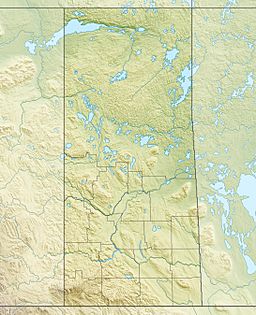Costigan Lake (Saskatchewan) facts for kids
Quick facts for kids Costigan Lake |
|
|---|---|
| Location | Saskatchewan |
| Coordinates | 56°57′00″N 105°54′02″W / 56.95000°N 105.90056°W |
| Type | Lake |
| Part of | Mackenzie River drainage basin and Churchill River drainage basin |
| Primary outflows | Geikie River |
| Basin countries | Canada |
| Surface elevation | 543 m (1,781 ft) |
Costigan Lake is a lake located in northern Saskatchewan, Canada. It's a really interesting lake because it's the starting point for a river called the Geikie River. This river then flows into a much larger lake known as Wollaston Lake.
Contents
About Costigan Lake
Costigan Lake is an important natural feature in the vast landscape of northern Saskatchewan. It's a freshwater lake, meaning its water is not salty like the ocean. The lake sits at an elevation of about 543 meters (which is about 1,781 feet) above sea level.
Where is Costigan Lake located?
Costigan Lake is found in the northern part of Saskatchewan, a province in Canada. This area is known for its many lakes, forests, and wild spaces. The exact location can be pinpointed using coordinates: 56°57′00″N 105°54′02″W. These numbers help scientists and explorers find the lake on a map.
What makes Costigan Lake special?
One of the most unique things about Costigan Lake is its role in a huge water system. It's the source of the Geikie River. This river flows into Wollaston Lake, which is quite unusual. Wollaston Lake is special because it drains into two different major river systems!
The Two River Systems
From Wollaston Lake, the water from Costigan Lake can end up in two very different places:
- The Churchill River system: Some water flows east through the Churchill River. This river eventually empties into Hudson Bay, which is part of the Atlantic Ocean.
- The Mackenzie River system: Other water flows north through the Mackenzie River. This mighty river travels a very long distance across Canada. It finally reaches the Arctic Ocean in the far north.
This means that water starting in Costigan Lake could travel thousands of kilometers to either the Atlantic or Arctic Oceans! It shows how connected all the lakes and rivers are in Canada's huge drainage basins.


